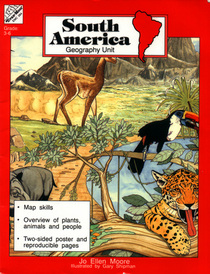Search -
South America
South America
Author:
Argentina, Bolivia, Brazil, Chile, Colombia, Ecuador, Guyana, Paraguay, Peru, Suriname, Uruguay, and Venezuela -- together they form the richly diverse South American continent. Now, with this one volume, your students can compare and contrast its peoples, customs, regions and political divisions. Topics and activities explored include: Locating... more »
Author:
Argentina, Bolivia, Brazil, Chile, Colombia, Ecuador, Guyana, Paraguay, Peru, Suriname, Uruguay, and Venezuela -- together they form the richly diverse South American continent. Now, with this one volume, your students can compare and contrast its peoples, customs, regions and political divisions. Topics and activities explored include: Locating... more »
ISBN-13: 9781557992420
ISBN-10: 1557992428
Publication Date: 1/1993
Pages: 16
Reading Level: Ages 9-12
Rating: 1
ISBN-10: 1557992428
Publication Date: 1/1993
Pages: 16
Reading Level: Ages 9-12
Rating: 1
4.5 stars, based on 1 rating
Publisher: Evan-Moor Educational Publishers
Book Type: Paperback
Members Wishing: 0
Reviews: Amazon | Write a Review
Book Type: Paperback
Members Wishing: 0
Reviews: Amazon | Write a Review
Genres:
- Children's Books >> Ages 9-12 >> General
- Children's Books >> History >> Central & South America
- Children's Books >> People & Places >> Explore the World >> Central & South America
- Children's Books >> Geography & Cultures
- Children's Books >> Geography & Cultures >> Cultural Studies >> General




